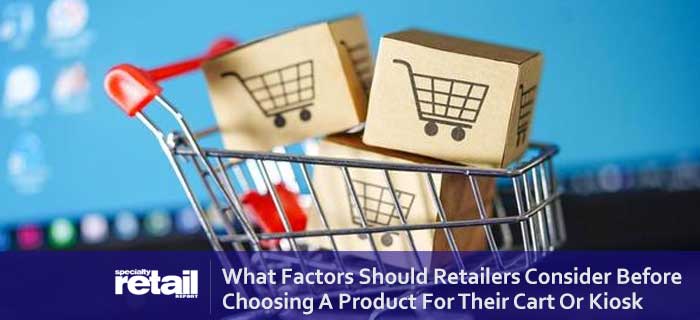As a retailer, it’s impossible to offer ALL types of products. It is especially true for brands that operate a cart or kiosk. Unlike traditional retail stores, the limited space of carts and kiosks involves making strategic decisions about product selection becomes crucial.
Retailers must identify a product mix that caters to their target consumers and bridges the gap in the market.
If a retailer randomly selects a product lineup, they are bound to experience bumps in the journey that can result in significant losses. A thoughtful approach to product selection can facilitate retailers to maximize profitability, customer satisfaction, and overall business performance.
Passion
Being passionate about the product mix offered is one of the crucial factors to consider. When retailers are genuinely passionate about the products they offer, it translates into enthusiasm, knowledge, and excellent customer service.
In addition, they will love talking about its benefits, usage, and features. This interest will attract customers and build trust in the retailer’s expertise.
Moreover, passion will drive a retailer to stay informed about industry trends, new developments, and customer preferences. They are more likely to search for unique, high-quality products that match their interests and values.
This factor also helps a retailer deal with challenges and offer practical solutions.
Once you know what you are passionate about, other elements of a business will automatically fall into place. For example, retailers will focus on only a few products and avoid over-extending themselves. Even though determining your passion is imperative, retailers should pay attention to the demand, profit potential, and market trends.
Target Market Analysis
To determine the right product for sale, it is imperative that business owners understand their target market. This analysis will help brands anticipate the customers’ needs who visit the mall, cart, or kiosk in a location. By conducting a market survey, businesses can sense the condition of the customers, allowing them to determine the right products. Moreover, it will facilitate them to design their marketing activities.
Knowing your target market is especially crucial for cart and kiosk retailers due to their limited space. Retailers should conduct comprehensive market research to identify their ideal customer demographic and preferences.
Factors such as gender, lifestyle, age, and income level should be considered before selling a product. In addition, retailers should stay up-to-date with market trends, emerging consumer preferences, and popular products within the target market.
It is best to select a specific target market to identify the products better. For instance, you can choose young, single men as a prospective target customer rather than selecting men. Retailers can tailor the shopping experience and increase their revenue by doing so.
Choose a Retail Theme
To create a bigger impact, it is vital that your cart or kiosk deals with one product category or has a particular theme. Selecting a singular theme allows you to easily direct your marketing efforts and ensure a uniform store layout.
Retailers can avoid deviating from the theme by choosing a product category that will fit their space. Generally, retailers that sell one variety are more successful than those everywhere. Tip: never over-merchandise a common area unit as it reduces the presentation.
Profit Margin and Pricing
Careful product selection is essential as it will determine the level of profits a retailer will earn. Although product appeal and demand should be considered, retailers must evaluate profit margins.
It involves assessing the cost of sourcing, production, transportation, and other associated expenses. When choosing a product vendor, compare prices to get a fair deal. Retailers should select products that offer a good and sustainable profit margin.
You can calculate profits by considering competition and customer price expectations. As a result, overpricing or underpricing of the products can be avoided.
High Markup Products
Products that have a significant difference between their cost and the selling price increase a retailer’s profit margins. You should choose products that offer at least a 300% markup.
It is imperative that the product you choose to sell can yield sales that are five times higher than the cost of your rent. Retailers can increase their profit percentage by comparing prices and selecting the right vendor.
Moreover, you can research wholesalers that offer discounts for bulk purchases and have a flexible return policy. Negotiate policies for returning the product if it doesn’t sell as expected.
To maximize profit potential, you can also branch out to other markets rather than JUST depending on wholesalers in the city. It is also essential to calculate the breakeven point. Estimate the quantity of the product you need to sell to cover expenses.
Products that Complement
Every retailer picks out a primary product considered its best seller and generates the maximum profit. However, you can sell additional items that complement your main article, as it will augment the transaction total.
For instance, if a kiosk owner sells cameras, they can also vend flash drives, batteries, camera cases, and adapters.
By selling these complimentary products, retailers solve future problems for the customers. Moreover, it increases their profits by boosting sales. You can convince your customers to purchase an additional camera battery as a backup. Naturally, retailers will have to understand the needs of their customers and up their offerings accordingly.
Seasonality in Product Selection
If you intend to make profits throughout the year, you must choose products that maintain a consistent demand. Retailers should opt for products that are suitable for all seasons. Brands that sell products only in the market half the year should consider expanding their offerings.
For example, during summer months, items like sunglasses, beach accessories, or refreshing beverages may be in high demand. In contrast, gift items, festive decorations, or specialty food products might attract more customers during the holiday season.
Retailers should consider a diverse product range that can cater to varying seasonal demands to maintain profits over the year.
Ensure Competitive Edge
High-profit items tend to have higher competition as more retailers want to jump into the market and gain from this lucrative option. Analyzing the competition for a product you wish to sell is crucial. They understand what other retailers offer and help identify gaps in the market and areas of differentiation.
Retailers must aim to differentiate themselves from the competition by offering unique products or presenting existing products in a new way. You can also pick out products that are not readily available.
Retailers can gain insightful details regarding pricing strategies, marketing techniques, and potential partnership opportunities when they analyze their competition. Consequently, retailers can tweak their offerings to stand out.
Inventory Management
After selecting the product you intend to sell, look into the inventory needed to support your venture. You will naturally have to see if the items can be stocked and what is their shelf life. The type of product will impact this aspect.
For example, you can stock many candles that do not change with the season. On the contrary, retailers that sell clothes will stock more variety of clothes instead of more quantity.
To Wrap it Up
Choosing the right products for a kiosk or cart is a critical decision that can significantly impact the success of a venture. To maximize profit potential, carefully considering factors that come into play during product selection is imperative.
Retailers should reflect on products that align with customer preferences, are priced competitively, and differentiate them from competitors.

Patricia Norins is a strategic storyteller in the retail industry. With nearly 30 years of experience, she expertly combines innovative marketing strategies and industry knowledge to effectively convey brand stories. Coming from a fourth-generation retailer family, Patricia has a deep-rooted passion for retail real estate and has pioneered concepts such as adding retail to common areas and creating specialty leasing programs. In addition to her professional achievements, she actively mentors and contributes to the community, including co-teaching MBA classes.



